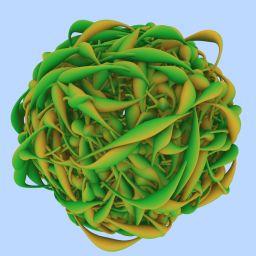Phantom Ray-Hair Intersector

We present a new approach to ray tracing swept volumes along trajectories defined by cubic Bézier curves. It performs at two-thirds of the speed of ray-triangle intersection, allowing essentially even treatment of such primitives in ray tracing applications that require hair, fur, or yarn rendering. At each iteration, we approximate a radially symmetric swept volume with a tangential cone. A distance from the ray-cone intersection to the cone's base is then used to compute the next curve parameter t. When this distance is zero, the ray intersects the swept volume and the cone at the same point and we stop the iterations. To enforce continuity of the iterative root finding, we introduce "phantom" intersection, padding the cone until it touches the ray if the ray-cone intersection does not exist.
Publication Date
External Links
Uploaded Files
Copyright
Copyright by the Association for Computing Machinery, Inc. Permission to make digital or hard copies of part or all of this work for personal or classroom use is granted without fee provided that copies are not made or distributed for profit or commercial advantage and that copies bear this notice and the full citation on the first page. Copyrights for components of this work owned by others than ACM must be honored. Abstracting with credit is permitted. To copy otherwise, to republish, to post on servers, or to redistribute to lists, requires prior specific permission and/or a fee. Request permissions from Publications Dept, ACM Inc., fax +1 (212) 869-0481, or permissions@acm.org. The definitive version of this paper can be found at ACM's Digital Library http://www.acm.org/dl/.
